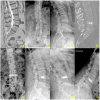Stand-Alone Lateral Lumbar Interbody Fusion at L3-L4 with 3D-Printed Porous Titanium Cages: A Safe and Effective Alternative in the Treatment of Degenerative Disc Disease (DDD)
- PMID: 40565978
- PMCID: PMC12193929
- DOI: 10.3390/jcm14124233
Stand-Alone Lateral Lumbar Interbody Fusion at L3-L4 with 3D-Printed Porous Titanium Cages: A Safe and Effective Alternative in the Treatment of Degenerative Disc Disease (DDD)
Abstract
Background/Objectives: Stand-alone lateral lumbar interbody fusion (LLIF) remains a debated approach in spinal surgery, with limited published evidence supporting its efficacy without supplemental fixation. This prospective study presents the institutional case series on single-level L3-L4 stand-alone LLIF, using next-generation 3D-printed titanium cages, as treatment for degenerative disc disease (DDD). Methods: A cohort of 49 patients with symptomatic DDD, unresponsive to conservative therapy, underwent stand-alone LLIF at L3-L4 (neither posterior pedicle screws nor lateral plating). Clinical outcomes (VAS and ODI) and radiological parameters (disc height, segmental/lumbar lordosis) were collected preoperatively and at 1, 6, and 12 months. Repeated-measures ANOVA with Bonferroni correction was adopted for statistical analysis. Results: Significant improvements were observed in pain and disability scores at all time points, with the mean VAS score decreasing from 6.53 to 0.29, and ODI from 27.6% to 3.84% at one year (p < 0.001). Radiographic analysis confirmed durable increases in disc height and segmental lordosis. Solid fusion was achieved in 97.9% of cases. No patient required posterior revision; transient neurological symptoms were mild and self-limiting. Conclusions: This study demonstrates that stand-alone LLIF at L3-L4 is safe and effective in achieving stable fusion and clinical-radiological improvement. These results challenge the necessity of supplemental fixation and support the broader adoption of a less invasive fusion paradigm.
Keywords: LLIF; degenerative disc disease; fusion; intervertebral disc; low back pain; minimally invasive spine surgery; spine.
Conflict of interest statement
The authors declare no conflicts of interest.
Figures


Similar articles
-
Maximizing screw length in expandable lateral lumbar interbody spacers with integrated fixation may obviate the need for supplemental pedicle screws.Spine J. 2025 Jul;25(7):1564-1573. doi: 10.1016/j.spinee.2025.01.035. Epub 2025 Jan 30. Spine J. 2025. PMID: 39890027
-
Usefulness of Lateral Lumbar Interbody Fusion Combined with Indirect Decompression for Degenerative Lumbar Spondylolisthesis: A Systematic Review.Medicina (Kaunas). 2022 Mar 29;58(4):492. doi: 10.3390/medicina58040492. Medicina (Kaunas). 2022. PMID: 35454331 Free PMC article.
-
Total disc replacement surgery for symptomatic degenerative lumbar disc disease: a systematic review of the literature.Eur Spine J. 2010 Aug;19(8):1262-80. doi: 10.1007/s00586-010-1445-3. Epub 2010 May 28. Eur Spine J. 2010. PMID: 20508954 Free PMC article.
-
A systematic review of anterior lumbar interbody fusion (ALIF) versus posterior lumbar interbody fusion (PLIF), transforaminal lumbar interbody fusion (TLIF), posterolateral lumbar fusion (PLF).Eur Spine J. 2023 Jun;32(6):1911-1926. doi: 10.1007/s00586-023-07567-x. Epub 2023 Apr 18. Eur Spine J. 2023. PMID: 37071155
-
Clinical outcomes after minimally invasive transforaminal lumbar interbody fusion and lateral lumbar interbody fusion for treatment of degenerative lumbar disease: a systematic review and meta-analysis.Neurosurg Rev. 2018 Jul;41(3):755-770. doi: 10.1007/s10143-016-0806-8. Epub 2016 Dec 24. Neurosurg Rev. 2018. PMID: 28013419
References
-
- Zheng J., Song Y., Yu B. GPNMB Suppresses Inflammation and Extracellular Matrix Degradation in Nucleus Pulposus Cells by Inhibiting Pro-Inflammatory Cytokine Production and Activation of the NF-κB Signaling Pathway. J Interferon Cytokine Res. 2025;45:238–246. doi: 10.1089/jir.2025.0022. - DOI - PubMed
-
- Schmidt H., Reitmaier S., Yang D., Duda G., Pumberger M. Degenerative relationships in lumbar intervertebral discs and facet joints: An MRI-based comparative study of asymptomatic individuals and patients with chronic and intermittent low back pain. Front. Bioeng. Biotechnol. 2025;13:1502082. doi: 10.3389/fbioe.2025.1502082. - DOI - PMC - PubMed
-
- Genitiempo M., Perna A., Santagada D.A., Meluzio M.C., Proietti L., Bocchi M.B., Logroscino C.A., Tamburrelli F.C. Single-level Bryan cervical disc arthroplasty: Evaluation of radiological and clinical outcomes after 18 years of follow-up. Eur. Spine J. 2020;29:2823–2830. doi: 10.1007/s00586-020-06486-5. - DOI - PubMed
LinkOut - more resources
Full Text Sources
Research Materials

